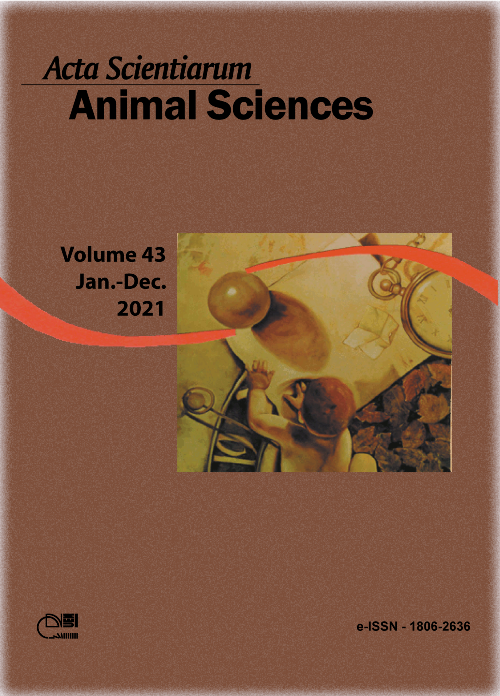Animal protein consumer's perception on the welfare of production animals in Belém, Pará State, Brazil
Abstract
The objective was to identify the level of knowledge of animal protein consumers about the welfare of production animals, in Belém city, Pará State, Brazil. The survey was carried out in two supermarkets, using 401 structured questionnaires, with 10 closed questions, with a “Yes” or “No” answer, taking into consideration, for the formation of a socioeconomic profile, questions related to gender, age group, educational level and family income of the interviewees. Most consumers of animal protein from the municipality of Belém, Pará State, Brazil, recognize that these products are part of their daily diet, however, the interviewees have no knowledge about the topic, and are not willing to pay more for the product with a seal of quality, as well as showing no interest or concern with the way animals are reared or slaughtered. The age group of consumers influences the level of knowledge about the welfare of production animals, observing that consumers aged 40 to 50 years have more knowledge on the subject. Education was a decisive factor in determining the level of knowledge of animal protein consumers about the welfare of production animals, as consumers from high school had more knowledge about the subject.
Downloads
References
Abreu, M. L., Dantas, G. S., Silva, W. C., Barbosa, A. V. C., & Silva, J. A. R. (2021). Percepção dos consumidores de proteína animal sobre o bem-estar dos animais de produção no município de Parauapebas, Pará, Brasil. Veterinária e Zootecnia, 28. 1-12. DOI: https://doi.org/10.35172/rvz.2021.v28.484
Andrade, J. P. S. C., Cecchin, D., Pinto, F. O., Nepomuceno, G. L., & Silva, F. C. (2019). Percepção dos consumidores sobre o bem-estar dos animais de produção em Niterói (RJ). Energia na Agricultura, 34(4), 501-510. DOI: https://doi.org/10.17224/EnergAgric.2019v34n4p201-510
Barcellos, M. D. (2004). Informação e qualidade na compra de carne bovina. Faces: Revista de Administração, 3(2), 43-59. DOI: https://doi.org/10.21714/1984-6975FACES2004V3N2ART35
Bonamigo, A., Bonamigo, C. B. S. S., & Molento, C. F. M. (2012). Atribuições da carne de frango relevantes ao consumidor: foco no bem-estar animal. Revista Brasileira de Zootecnia, 41(4), 1044-1050. DOI: 10.1590/S1516-35982012000400029
Francisco, D. C., Nascimento, V. P., Loguercio, A. P., & Camargo, L. (2007). Caracterização do consumidor de carne de frango em Porto Alegre. Ciência Rural, 37(1), 253-258. DOI: http://dx.doi.org/10.1590/S010384782007000100041
Fraser, A. F., & Broom, D. M. (2002). Farm animal behaviour and welfare. Wallingford, UK: CABI.
Hotzel, M. J., & Machado Filho, L. C. P. (2004). Bem-estar animal na agricultura do Século XXI. Revista de Etologia, 6(1), 3-15.
Instituto Brasileiro de Geogradia e Estatistica (IBGE). (2010). Censo demográfico 2010 - Características da População e dos Domicílios: Resultados do Universo. Brasília, DF: IBGE.
Levin, J. (1987). Estatística aplicada a ciências humanas. São Paulo, SP: Harbra.
Miranda de la Lama, G., Estévez-Moreno, L., Sepúlveda, W., Estrada-Chavero, M., Rayas-Amor, A., Villarroel, M., & Maria, G. A. (2017). Mexican consumers’ perceptions and attitudes towards farm animal welfare and willingness to pay for welfare friendly meat products. Meat Science, 125, 106-113. DOI: https://doi.org/10.1016/j.meatsci.2016.12.001
Molento, C. F. M. (2005). Bem-estar e produção animal: aspectos econômicos - Revisão. Archives of Veterinary Science, 10(1), 1-11. DOI: http://dx.doi.org/10.5380/avs.10i1.4078
Pinheiro, M. C., Gomes, F. E., & Lopes, G. N. (2008). Perfil e preferência de consumo da carne bovina na cidade de Boa Vista Roraima (RR). Agro@mbiente On-line, 2(1),28-36. DOI: http://dx.doi.org/10.18227/1982-8470ragro.v2i1.157
Queiroz, M. L. D. V., Barbosa-Filho, J. A. D., Albiero, D., Brasil, D. D. F., & Melo, R. P. (2014). Consumer perception about welfare of livestock in Fortaleza, Ceará, Brazil. Revista Ciência Agronômica, 45(2), 379-386. DOI: https://doi.org/10.1590/S1806-66902014000200020
Raineri, C. R., Antonelli, N., Prosdocimi, C., Simionato De Barros, A. M., Tarazona., & Gameiro, A. H. (2012). Contribution to economic evaluation of systems that value animal welfare at farm. Revista Colombiana de Ciências Pecuárias, 25(1), 123-134.
Rocha, J. S. R., Lara, L. J. C., & Baião, N. C. (2008). Produção e bem-estar animal aspectos éticos e técnicos da produção intensiva de aves. Ciências Veterinárias nos Trópicos, 11(1), 49-55.
Schaly, L. M., Oliveira, M. C., Salviano, P. A. P., & Abreu, J. M. (2010). Percepção do consumidor sobre bem-estar de animais de produção em Rio Verde, GO. Pubvet, 4(38), 1982-1263.
Silva, W. C., Silva, J. A. R., & Silva, E. B. R. (2020). Percepção do consumidor de pro-teína animal sobre o bem-estar dos animais de produção em Santarém, Pará, Brasil. Revista CES Medicina Veterinária e Zootecnia, 15(2), 64-74. DOI: http://dx.doi.org/10.21615/cesmvz.15.2.5
Souza, M. C. G. L., Casot, L. M., & Lemme, C. F. (2013). Consumo consciente como determinante da sustentabilidade empresarial: respeitar os animais pode ser um bom negócio? Revista de Administração, 6(Edição Especial), 229-246. DOI: https://doi.org/10.5902/198346599022
Vargas-Bello-Pérez, E., Riveros, J. L., Köbrich, C., Álvarez-Melo, P. A., & Lensink, J. (2017). Chilean consumers’ perception about animal welfare in dairy production systems: Short communication. Animal Production Science, 57(1), 147-151. DOI: https://doi.org/10.1071/AN14968
Velho, J. P., Barcellos, J. O. J., Lengler, L., Elias, S. A., & Oliveira, T. E. (2009). Disposição dos consumidores porto-alegrenses à compra de carne bovina com certificação. Revista Brasileira de Zootecnia, 38(2), 399-404. DOI: https://doi.org/10.1590/S1516-35982009000200025
Zeder, M. A., & Hesse, B. (2000). The initial domestication of goats (Capra hircus) in the Zagros mountains 10,000 years ago. Science, 287, 2254-2257. DOI: https://doi.org/10.1126/science.287.5461.2254
DECLARATION OF ORIGINALITY AND COPYRIGHTS
- I Declare that current article is original and has not been submitted for publication, in part or in whole, to any other national or international journal.
The copyrights belong exclusively to the authors. Published content is licensed under Creative Commons Attribution 4.0 (CC BY 4.0) guidelines, which allows sharing (copy and distribution of the material in any medium or format) and adaptation (remix, transform, and build upon the material) for any purpose, even commercially, under the terms of attribution.
Read this link for further information on how to use CC BY 4.0 properly.








































